Prevalence of cryptosporidiosis in animals in Iran: A systematic review and metaanalysis
Mohammad Jokar, Mohammad Hasan Rabiee, Saied Bokaie✉, Vahid Rahmanian, Paria Dehesh, Hamideh Hasannejad, Kiavash Hushmandi, Hadi Keshipour
1Faculty of Veterinary Medicine, Karaj Branch, Islamic Azad University, Karaj, Iran
2Divisions of Epidemiology, Department of Food Hygiene and Quality Control, Faculty of Veterinary Medicine, University of Tehran, Iran
3Zoonoses Research Center, Jahrom University of Medical Sciences, Jahrom, Iran
4Department of Epidemiology, School of Public Health, Iran University of Medical Sciences, Tehran, Iran
ABSTRACT
KEYWORDS: Cryptosporidiosis; Animals; Prevalence; Iran
1. Introduction
Cryptosporidium is one of the zoonotic parasites. It is a genus in the family Cryptosporiidae, suborder Eimeriorina, order Eucoccidiorida, subclass Coccidiasina, class Sporozoasida and phylum Apocomplexa[1]. The protozoan, for first time identified by Tyzzer (1907) in mice and so far nearly 40 valid species and more than 50 genotypes of it has been recognized. This parasite infects a wide range of vertebrates including mammals, birds, amphibians,reptiles and aquatic animals and affects the epithelial cells of their gastrointestinal tract to causes a disease with a wide range of form, from asymptomatic to mild and severe gastrointestinal symptoms[2,3].
Cryptosporidiosis is one of the major causes of diarrheal death in children less than five years old and young animals,especially neonatal of ruminants[4,5]. Furthermore, this infection is life-threatening for immunosuppressed patient, notably HIV-infected people that recent systematic review has shown a high prevalence of cryptosporidiosis in them[6,7]. Various clinical signs of cryptosporidiosis are reported in mammals and birds such as diarrhea, anorexia, lethargy, lower pigmentation, apathy and depression, growth retardation and finally death[8,9].
Cryptosporidiosis in companion animals is asymptomatic but infrequently with concurrent infections, different signs have been reported in horses, cats and dogs[9,10]. The important economic losses in ruminants farms are caused by acute diarrhea[9,11]. This infection frequently occurs in reptiles but may be life-threatening for them[12].
Several concerns exist in the global control of cryptosporidiosis:firstly, different transmission routes such as person-to-person,human-animal, foodborne and waterborne transmission; secondly,inefficiency of water disinfectants against Cryptosporidium oocyte;thirdly, the absence of a vaccine and effective treatment[13,14].
The epidemiological aspects of cryptosporidiosis among animals’populations can be useful for setting control plans. To the best of our knowledge, till now, there is no available knowledge about the pooled prevalence of Cryptosporidium infection in animals’populations of Iran. Accordingly, we conducted a systematic review and meta-analysis to establish the overall prevalence of cryptosporidiosis in animals in Iran.
2. Materials and methods
This study was designed as suggested via the preferred reporting items for systematic reviews and meta-analyses (PRISMA)[15].
2.1. Bibliographic search strategy
The relevant studies have been identified from 1 January 2000 to 1 January 2020 from six English sources i.e. PubMed, Springer,Google Scholar, Science Direct, Scopus, and Web of Science and two Persian databases namely Magiran, and Scientific Information Database (SID). The search was implemented using the MeSH terms as follows: “Cryptosporidium” or “cryptosporidiosis” or“intestinal parasite” and “Iran” in combination and in both Persian(Farsi) and English. In addition, the datasets option of “related articles” and the reference of the studies was checked to prevent missing data. The selection process of studies is in view in the PRISMA flowchart as shown in Figure 1.
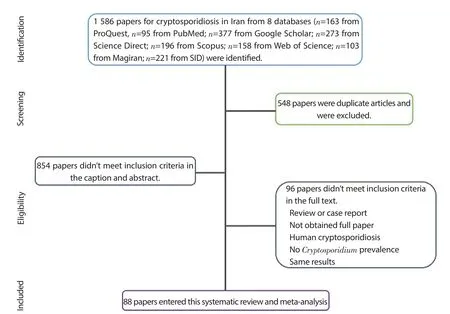
Figure 1. PRISMA flowchart presenting the selection of articles analyzed in this systematic review and meta-analysis.
2.2. Inclusion and exclusion criteria
The title and abstract of studies related to animal cryptosporidiosis in Iran were screened. After eliminating duplicates, the full text of papers was reviewed by two reviewers independently for assessing the quality of the articles. Differences of opinion between the specialists were resolved by a third person independently and consensus.
Inclusion criteria for our study were: (1) studies conducted on animal’s population of Iran; (2) studies that reported prevalence of cryptosporidiosis; (3) studies which diagnosed cryptosporidiosis based on microscopic method.
Exclusion criteria included the following: (1) any studies whose type was non-cross-sectional (experimentally, case report and etc.); (2) studies not performed on Iran; (3) studies not performed on animal populations; (4) studies not reported prevalence of cryptosporidiosis; (5) studies not detected Cryptosporidium based on microscopic methods; (6) studies in which the method of detecting Cryptosporidium was ambiguous.
2.3. Data collection
An Excel data extraction form was used to collect the following data from eligible studies: first author, time of publication, time of study, place of study, animal species, diagnostic tests, sample size, total Cryptosporidium-positive number, prevalence, age group,gender, type of habitat or farming system, absence or presence of diarrheal sign and season (Table 1).

Table 1. Studies included in this systematic review and meta-analysis.
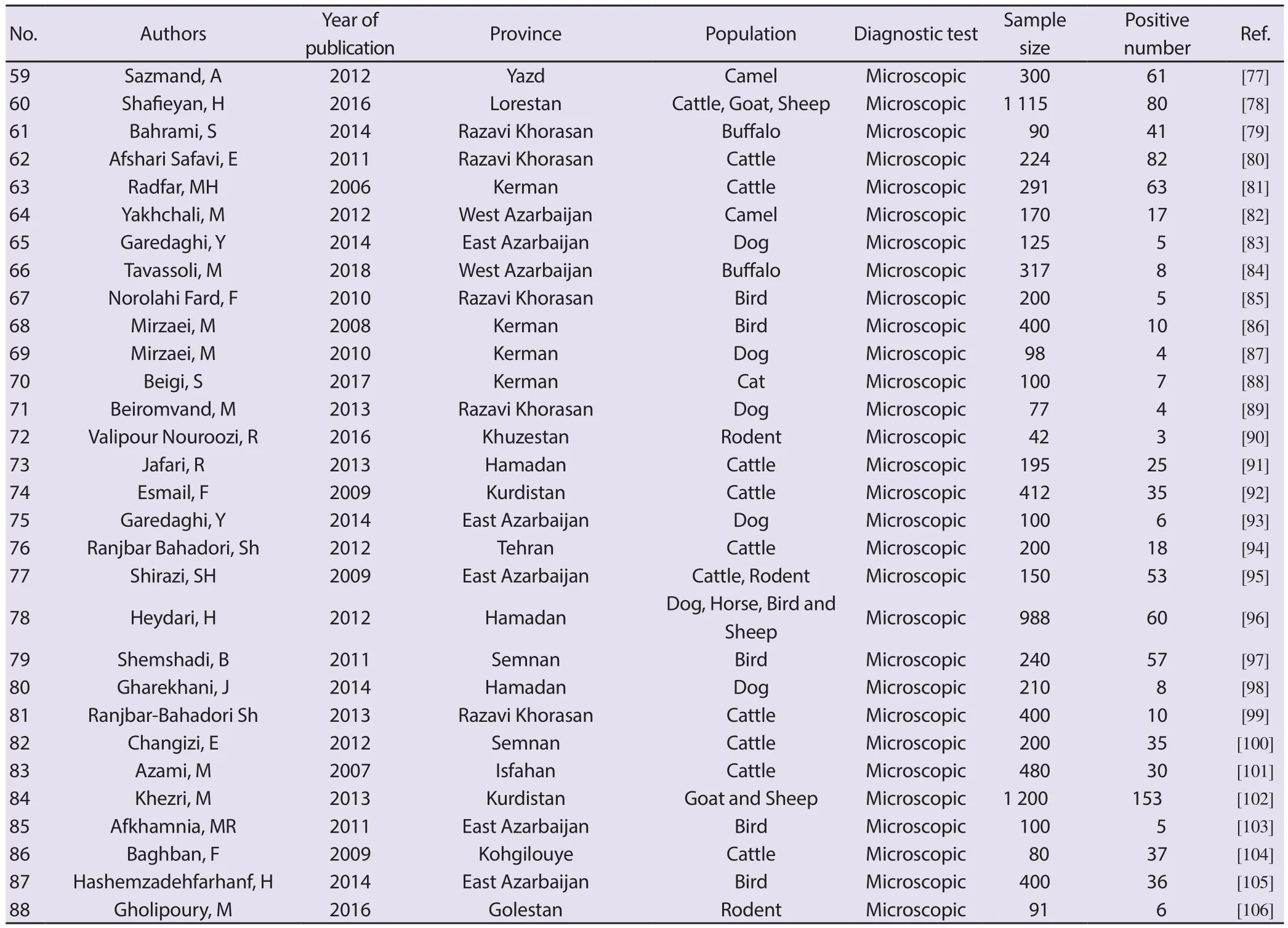
Table 1. Continued.
2.4. Statistical analysis
The pooled prevalence and 95% confidence intervals (CI)were estimated using random and fixed-effects models. The heterogeneity was expected in advance, and statistical methods,Cochran’s Q test and Iindex were used to assess the heterogeneity among the studies[16]. if Iindex > 50% and Cochran’s Q test P-value < 0.1, we would choose the random effect model for estimation[17]. Proportions of individual studies, overall prevalence and the heterogeneity among studies were presented by forest plots.
The publication bias of studies was assessed by Egger’s test[18].To visualize the cattle and dogs cryptosporidiosis in Iran, we used the Arc GIS 10.3 software (https://www.arcgis.com) to map the distribution of prevalence in different provinces. The meta-analysis was performed with the trial version of StatDirect statistical software available from public domain i.e. http://statdirects.com.
3. Results
3.1. Search results and eligibility studies
In this study, totally 1586 articles were found by searching the entire databases; by systematic review and meta-analysis by considering the inclusion criteria. Among them, 548 articles were removed due to duplication and 854 articles were removed due to non-compliance with inclusion and exclusion criteria in caption and abstract. Also, 96 articles were removed due to non-compliance with inclusion and exclusion criteria in full text. Eventually 88 studies have met the evaluation criteria of this study (Figure 1).
3.2. Characteristics of the eligible studies
Among the 88 eligible studies, 22 were published before 2010 and others published after 2010. Among the studies, 78 studies determined prevalence only in one species of animal, while 10 studies determined the prevalence in more than one species. In the other words, studies determined prevalence are as follows: 30 among cattle, 19 among dogs, 16 among birds 10 among rodent,7 among sheep, 6 among camels, 5 among horses, 3 among cat, 3 among goats, 2 among buffalos, 1 among fish and 1 among mules.Also, 86 studies reported prevalence only in one province while 2 studies reported prevalence in more than one province (Table 1).
3.3. Prevalence of cryptosporidiosis
3.3.1. Prevalence of cryptosporidiosis in cattle
A total number of 8684 cattle were examined for cryptosporidiosis in different geographical locations in Iran and 1316 cases were detected positive using microscopic method presented (Table 2). Overall, the pooled prevalence of cryptosporidiosis using random-effects meta-analysis among cattle was estimated at 16.8% (95% CI 13.4%-20.1%) (Table 2 and Figure 2). There was a high degree of heterogeneity in the prevalence estimates between different studies. It was observed Q statistic=958.45 (df=29), P<0.01, and I=97.0% (Table 2). The pooled prevalence of cryptosporidiosis in cattle was higher in summer, diarrheal patients, bulls and cattle less than 1 year old but none of them had a significant difference (Table 3). In addition, a schematic map of cryptosporidiosis distribution in cattle was made based on studies conducted in the provinces of Iran (Figure 3).

Table 2. Overall prevalence of cryptosporidiosis in different species.
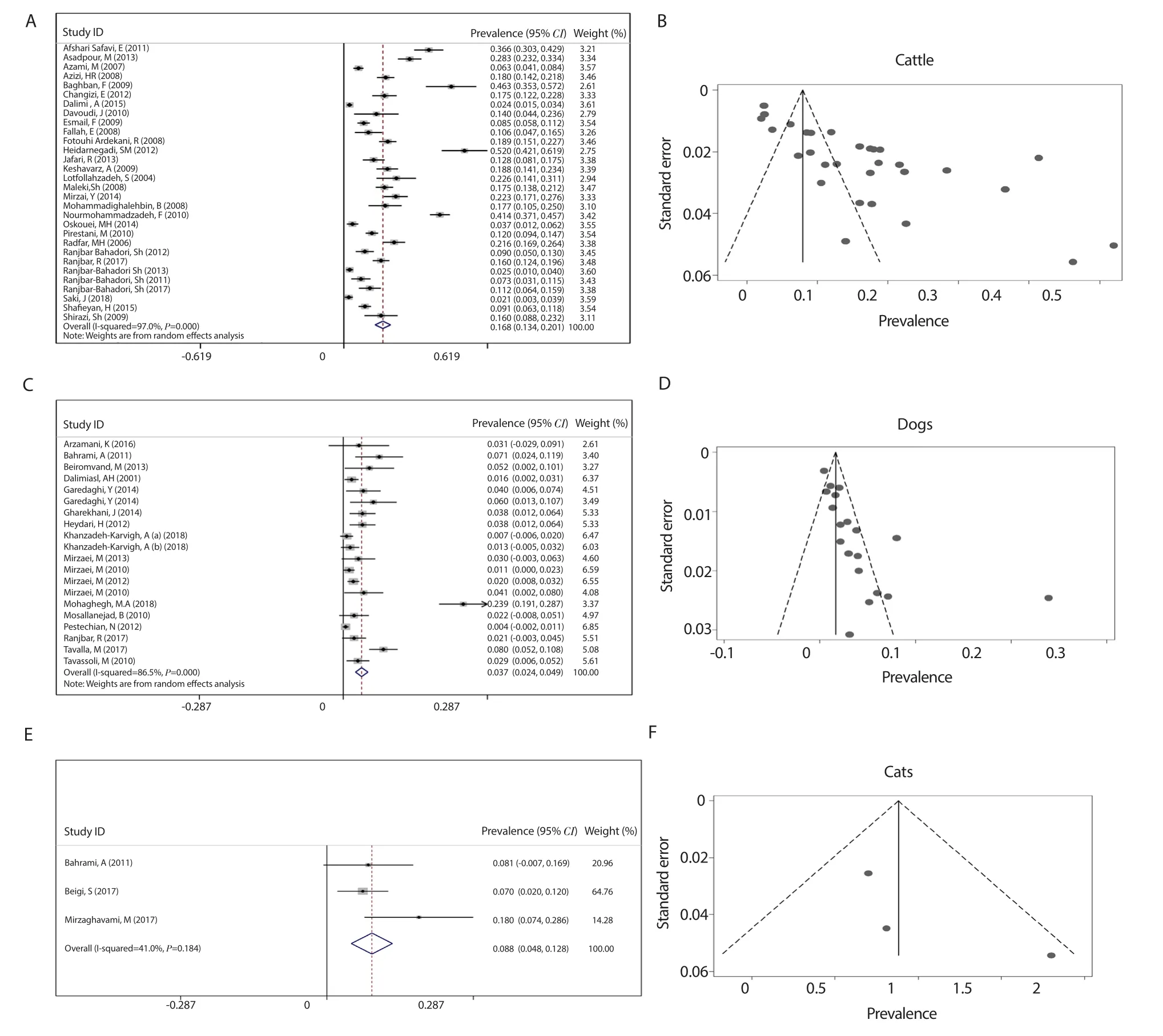
Figure 2. Forest plots of prevalence of cryptosporidiosis among cattle (A), dogs (C), and cats (E) in Iran ( first author, year) with funnel plot for visualization of publication bias in studies of cattle (B), dogs (D) and cats (F).
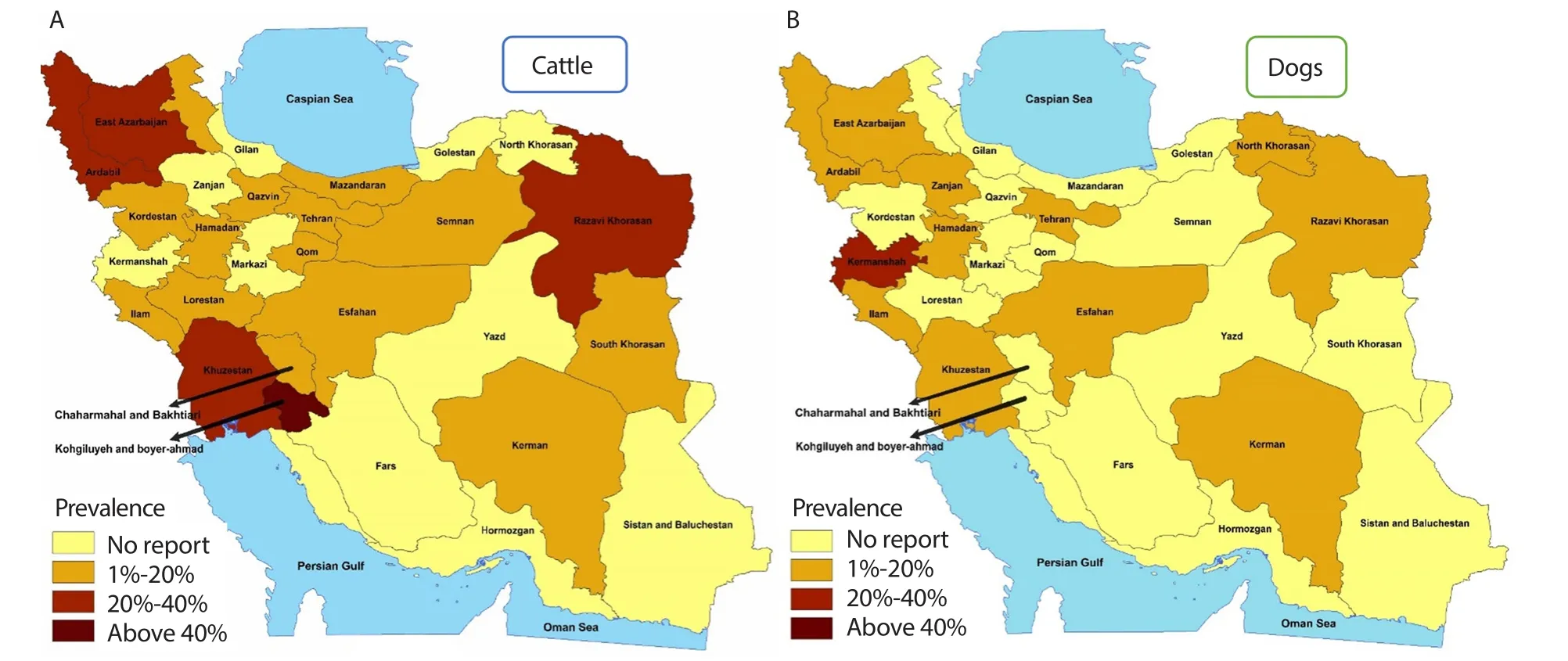
Figure 3. Prevalence of cryptosporidiosis among cattle (A) and dogs (B) in different provinces of Iran.
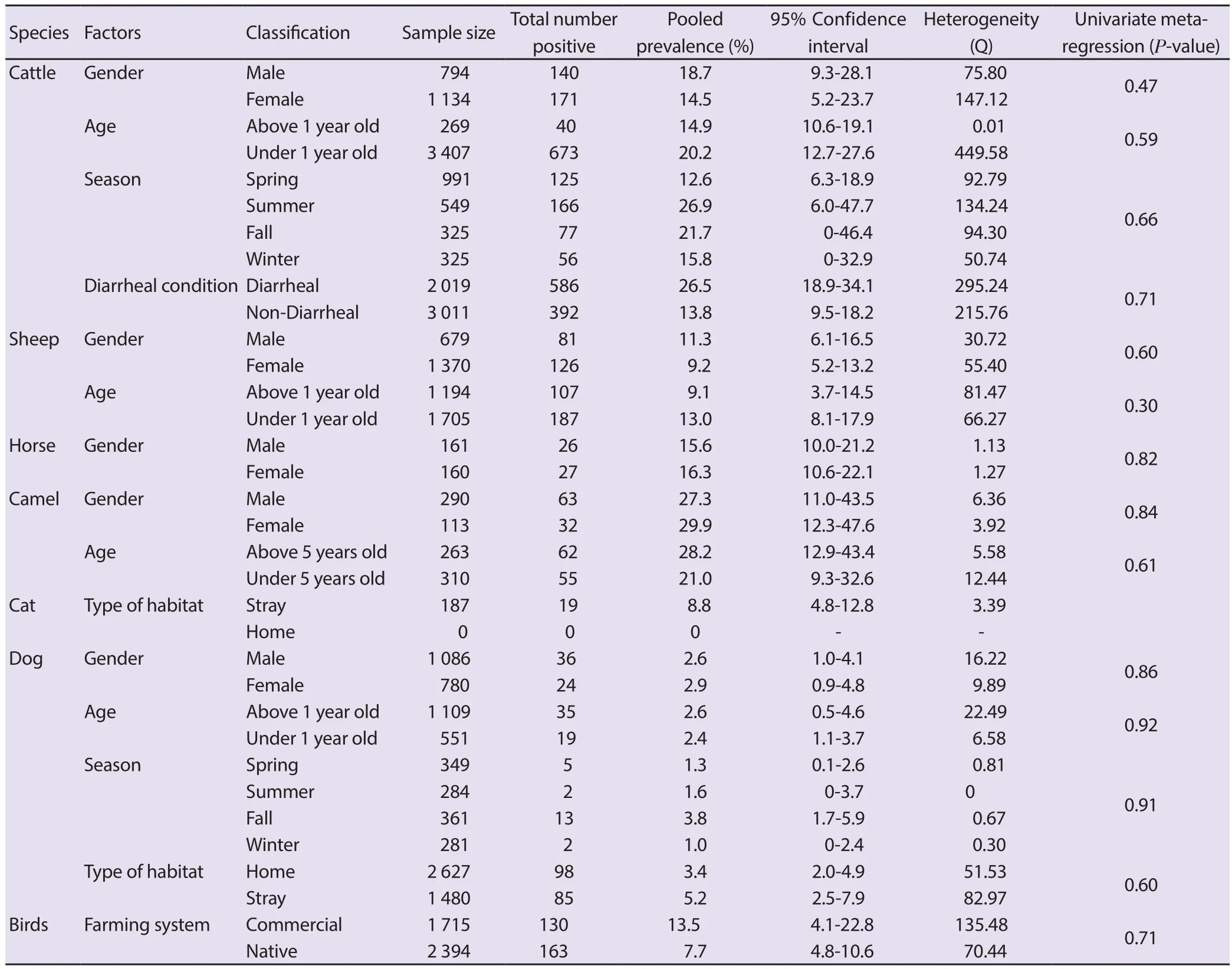
Table 3. Demographic factors associated with positivity of Cryptosporidium in the Iranian animal population.
3.3.2. Prevalence of cryptosporidiosis in dogs
A total number of 4107 dogs were examined for cryptosporidiosis in different geographical locations in Iran and 183 cases were detected positive using microscopic method as presented (Table 2).Overall, the pooled prevalence of cryptosporidiosis using randomeffects meta-analysis among dogs was estimated at 3.7% (95% CI 2.4%-4.9%) (Table 2 and Figure 2). There was a high degree of heterogeneity in the prevalence estimates between different studies was observed Q statistic=141.01 (df=19), P<0.01, and I=86.5% (Table 2). The pooled prevalence of cryptosporidiosis in dogs was higher in fall, stray dogs, female and dog’s upper than 1 year old but none of them had a significant difference (Table 3). In addition,a schematic map of cryptosporidiosis distribution in dogs was made based on studies conducted in the provinces of Iran (Figure 3).
3.3.3. Prevalence of cryptosporidiosis in cats
A total number of 187 cats were examined for cryptosporidiosis in different geographical locations in Iran and 19 cases were detected positive using microscopic method as presented (Table 2).The results show that there are 3 studies estimate the prevalence of Cryptosporidium in 187 stray cats and the pooled prevalence was 8.8% (95% CI 4.8%-12.8%) using the fixed-effect model (Table 2 and Figure 2). There was an intermediate degree of heterogeneity in the prevalence estimates between different studies. It was observed Q statistic=3.39 (df=2), P=0.184, and I=41.0% (Table 2).
3.3.4. Prevalence of cryptosporidiosis in sheep
A total number of 3901 sheep were examined for cryptosporidiosis in different geographical locations in Iran and 395 cases were detected positive using microscopic method as presented (Table 2). Overall, the pooled prevalence of cryptosporidiosis using random-effects meta-analysis among sheep was estimated at 9.9% (95% CI 7.0%-12.8%) (Table 2 and Figure 4). There was a high degree of heterogeneity in the prevalence estimates between different studies. It was observed Q statistic=114.90 (df=11), P<0.01, and I=90.4% (Table 2). The pooled prevalence of cryptosporidiosis in sheep was higher in male and sheep under 1 year old but none of them had a significant difference (Table 3).
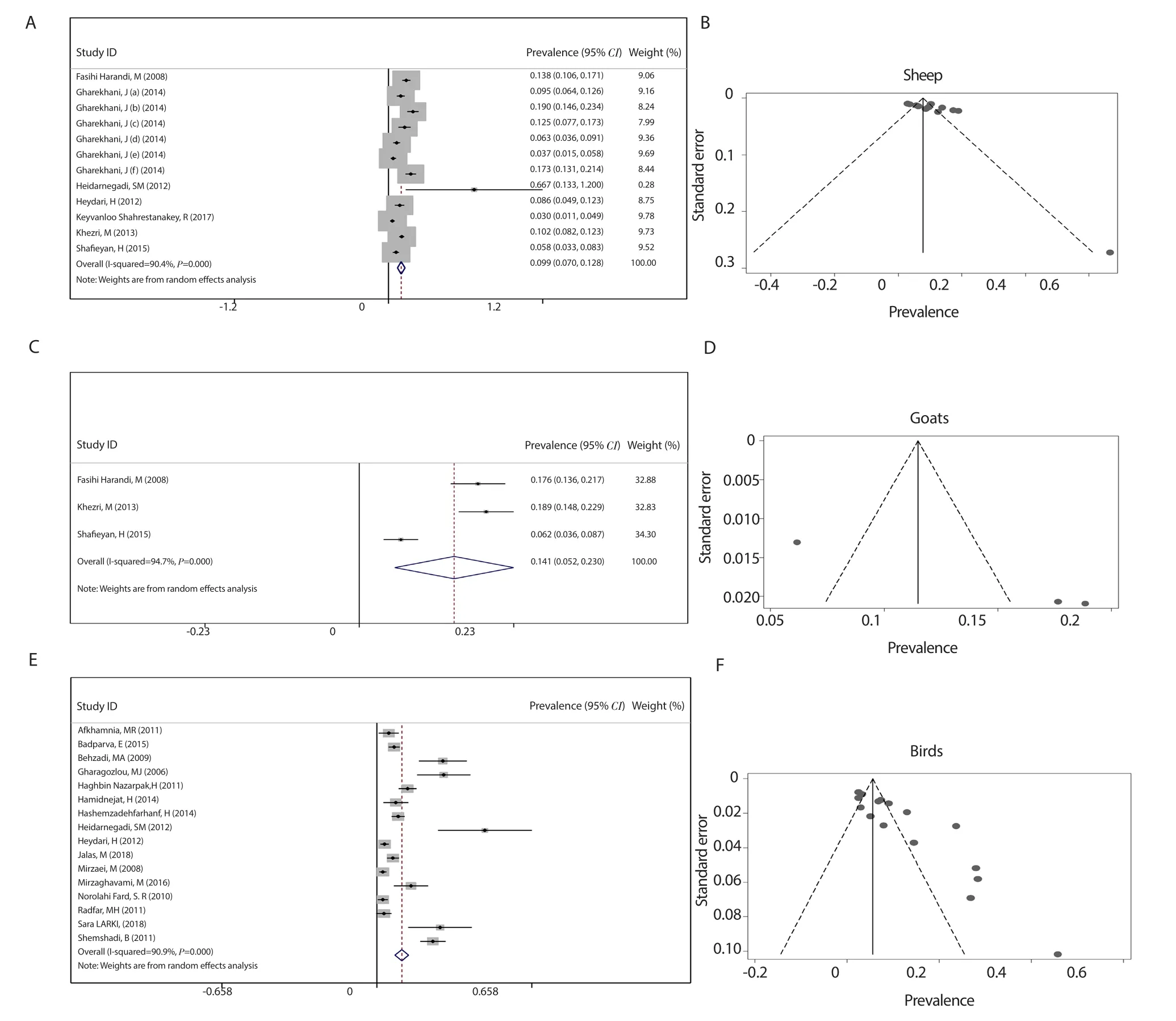
Figure 4. Forest plots of prevalence of cryptosporidiosis among sheep (A), goats (C), and birds (E) in Iran ( first author, year) with funnel plot for visualization of publication bias in studies of sheep (B), goats (D) and birds (F).
3.3.5. Prevalence of cryptosporidiosis in goats
A total number of 1030 goats were examined for cryptosporidiosis in different geographical locations in Iran and 147 cases were detected positive using microscopic method as presented (Table 2). The results show that there are 3 studies estimate the prevalence of Cryptosporidium in goats and the pooled prevalence using the random effects model of 14.1% (95% CI 5.2%-23.0%) (Table 2 and Figure 4). There was a high degree of heterogeneity in the prevalence estimates between different studies.It was observed Q statistic=37.87 (df=2), P<0.01, and I=94.7%(Table 2).
3.3.6. Prevalence of cryptosporidiosis in birds
A total number of 3352 birds were examined for cryptosporidiosis in different geographical locations in Iran and 307 cases were detected positive using microscopic method as presented (Table 2).Overall, the pooled prevalence of cryptosporidiosis, using randomeffects meta-analysis among birds was estimated at 10.5% (95%CI 7.6%-13.4%) (Table 2 and Figure 4). There was a high degree of heterogeneity in the prevalence estimates between different studies. It was observed Q statistic=165.28 (df=15), P<0.01, and I=90.9% (Table 2). The pooled prevalence of cryptosporidiosis in birds was higher in commercial farming system but there was no significant difference (Table 3).
3.3.7. Prevalence of cryptosporidiosis in horses
A total number of 636 horses were examined for cryptosporidiosis in different geographical locations in Iran and 85 cases were detected positive using Microscopic method as presented (Table 2).Overall, the pooled prevalence of cryptosporidiosis using randomeffects meta-analysis among horses was estimated at 12.2% (95%CI 8.3%-16.2%) (Table 2 and Figure 5). There was an intermediate degree of heterogeneity in the prevalence estimates between different studies. It was observed Q statistic=9.49 (df=4), P=0.05,and I=57.9% (Table 2). The pooled prevalence of cryptosporidiosis in horses was higher in female horses but there was no significant difference (Table 3).
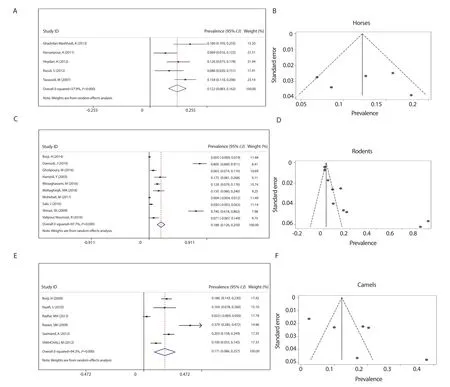
Figure 5. Forest plots of prevalence of cryptosporidiosis among horses (A), rodents (C), and camels (E) in Iran (first author, year) with funnel plot for visualization of publication bias in studies of horses (B), rodents (D) and camels (F).
3.3.8. Prevalence of cryptosporidiosis in rodents
A total number of 976 rodents were examined for cryptosporidiosis in different geographical locations in Iran and 133 cases were detected positive using microscopic method as presented (Table 2). Overall, the pooled prevalence of cryptosporidiosis using random-effects meta-analysis among rodents was estimated at 18.8% (95% CI 12.6%-25.0%) (Table 2 and Figure 5). There was a high degree of heterogeneity in the prevalence estimates between different studies. It was observed Q statistic=384.85 (df=9), P<0.01, and I=97.7% (Table 2).
3.3.9. Prevalence of cryptosporidiosis in camel
A total number of 1029 camels were examined for cryptosporidiosis in different geographical locations in Iran and 187 cases were detected positive using microscopic method as presented (Table 2). Overall, the pooled prevalence of cryptosporidiosis using random-effects meta-analysis among camels was estimated at 17.1% (95% CI 8.6%-25.7%) (Table 2 and Figure 5). There was a high degree of heterogeneity in the prevalence estimates between different studies. It was observed Q statistic=87.27 (df=5), P<0.01, and I=94.3% (Table 2). The pooled prevalence of cryptosporidiosis in camels was higher in female and camels upper than 5 years old but none of them had a significant difference (Table 3).
3.3.10. Prevalence of cryptosporidiosis in other animals
Two studies reported the prevalence in buffalo was 45% and 2% respectively. One study reported the prevalence in mules was 12.5% and one study reported prevalence in fish was 17% (Table 2).
3.4. Publication bias
Egger tests were applied to check the presence of publication bias.The Egger’s test in cattle, sheep, goats, dogs, birds, and rodents,indicated a significant publication bias of studies (Table 2).
4. Discussion
In this systematic review and meta-analysis, we reviewed the prevalence of cryptosporidiosis among all animals’ species in Iran.To detect cryptosporidiosis, there are microscopic, serological, and molecular methods, each with its own characteristics. However,acid-fast staining of fecal smear for displaying the Cryptosporidium oocytes is one practical and rapid method[107,108]and in lowincome countries, this method is commonly used because of inexpensive, simple and having a high positive predictive value for Cryptosporidium[109,110]. Therefore, in this meta-analysis, the pooled prevalence of cryptosporidiosis was estimated among the studies that had reported the prevalence of this infection in Iran using microscopic methods.
In this study, we indicated that the pooled prevalence among animal of Iran was between 3.7% to 18.8% and the pooled prevalence respectively was high to low as follows: rodent,camel, cattle, goats, horse, birds, sheep, cat and dog. Notably we prioritized it regardless of study of buffalo, fish and mule which had less than two studies. This different prevalence among animal can be due to different susceptibility of animals to the Cryptosporidium and also different raising and living areas. Anyway,In general, this result shows that the disease has been reported in a wide range of animals in Iran for many years and it is necessary to pay more attention to it among animals because of its economic and public health importance.
As we showed, rodents have the highest pooled prevalence of cryptosporidiosis compared to other animals of Iran. Indeed,the pooled prevalence of cryptosporidiosis in rodents using the microscopic detection method was estimated at 18.8% in the present study. A global meta-analysis estimated the pooled prevalence of cryptosporidiosis using the microscopic method was 14% in rodents[111]. The infection of different rodent species by Cryptosporidium spp. has been reported in different parts of the world, as well as the transmission of this pathogen by rodents to humans has been proven[111,112]. Besides, in recent decades, the rapid development of industry and agriculture, climate change has increased the probability of humans-rodents contact[113]. Therefore,considering that the estimated pooled prevalence of rodent’s cryptosporidiosis was high in Iran and given presence of various species of rodent in different parts of the country, it is essential to control rodent’s population and accessibility of them to water and food supply for reaching one health condition.
In addition to rodents, this study indicated that prevalence of cryptosporidiosis among other mentioned animals was remarkable.For instance, the prevalence among camels, cattle, goats, horses,birds and sheep was as follows: 17.1%, 16.8%, 14.1%, 12.2%,10.5% and 9.9%. Although cryptosporidiosis is important in all of these animals, it is more important in cattle, and most studies published on animal cryptosporidiosis in different countries have been conducted on bovine cryptosporidiosis. So far,different meta-analyses have determined pooled prevalence of cryptosporidiosis among cattle in different regions. For instance,a meta-analysis study in China estimated the pooled prevalence of cryptosporidiosis in cattle till 2019, regardless of the type of detection method, was 17%, and with the microscopic method being 16.5% [114]. Also, other meta-analyses conducted in Nigeria and Colombia estimated the pooled prevalence of this infection in cattle, regardless of the diagnostic method, was 26.1% and 21%,respectively[115,116]. Although the disease rarely causes death in cattle and calves, it can cause great economic losses to the industry due to diarrhea, dehydration and weight loss[117]. Furthermore,the bovine population is one of the most important animal reservoirs in disease transmission to humans by shedding oocytes and consequently contaminating of water and food supply[118].Therefore, given high pooled prevalence among cattle in Iran, it is important to control of the disease in cattle population to prevent Cryptosporidium transmission to other hosts and especially human and also to reduce the economic losses due to its occurrence.
The lowest pooled prevalence of cryptosporidiosis among animals of Iran was in cats and dogs population with 8.8% and 3.7% respectively. A global meta-analysis in the dog’s population estimated the pooled prevalence of cryptosporidiosis(using the microscopic method) was 8% and the range of pooled prevalence was from 0% to 13% in different parts of the world[119].Furthermore, the meta-analysis study in Colombia estimated the pooled prevalence of Cryptosporidium infection in dogs and cats was 17.4% and 13%, respectively[116]. The much lower prevalence of this disease in dogs in this study, as well as to some extent in similar studies, could be due to the fact that the majority of dogs studied are domestic dogs and because of the greater attention of their owners, the possibility of infection in them is less. However,various studies have proven the role of dogs and cats in transmitting the disease to humans. Besides, dogs and cats are known as the most important human friends and keeping dogs and cats at home has increased in the last decade in Iran[120]. Accordingly, observing hygienic practices for veterinarians and providing instruction for animal lovers before preparing dogs and cats can help control this infectious zoonotic aspect.
The strengths of this study include the large total sample size, the comprehensive literature search in eight international and Iranian databases, and vast population study (all animal species). However,this study has some limitations and the results presented here should be interpreted with regard to these limitations. Limitations include some reports with low sample size, high heterogeneity, and the possibility that our search strategy missed some studies.
In conclusion, the results of this systematic review and metaanalysis showed that cryptosporidiosis has been reported and present in a wide range of animals in Iran over the years and has a high prevalence in most of these species. Given that this disease causes economic and health damage, there is a need for health officials, veterinarians and livestock owners to try to improve the breeding environment and life of animals to prevent disease in them, not only to protect animal health and prevent economic losses in the case of farmed animals, but also to protect human health.
Conflict of interest statement
The authors declare that there are no conflicts of interest.
Authors’ contributions
M.H.R, S.B and V.R participated in study design. M.J, P.D,H.H, K.H and H.K did literature mining and data acquisition. M.J and M.H.R drafted the manuscript. Review and editing of the manuscript were done by M.H.R, M.J, S.B and V.R. All authors approved the final draft for publication
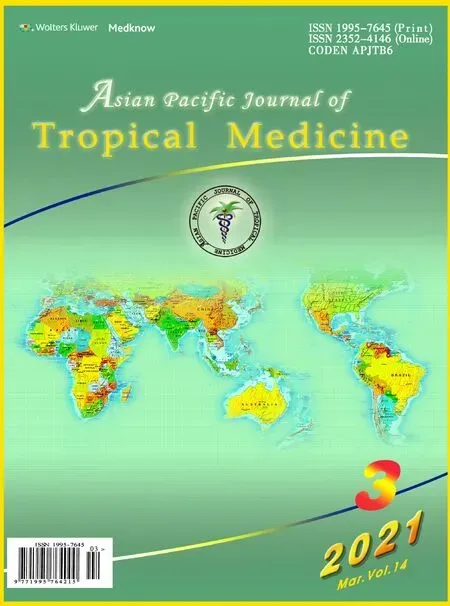 Asian Pacific Journal of Tropical Medicine2021年3期
Asian Pacific Journal of Tropical Medicine2021年3期
- Asian Pacific Journal of Tropical Medicine的其它文章
- Genotype 4 reassortant Eurasian avian-like H1N1 swine flu virus: An emerging public health challenge
- SARS-CoV-2 may impair pancreatic function via basigin: A single-cell transcriptomic study of the pancreas
- Burkholderia pseudomallei infection manifests as mediastinal/hilar lymphadenopathy:A case report
- In vitro anti-plasmodial activity of new synthetic derivatives of 1-(heteroaryl)-2-((5-nitroheteroaryl)methylene) hydrazine
- How knowledge of hepatitis B disease and vaccine influences vaccination practices among parents in Ho Chi Minh City, Vietnam
- Prevalence and intensity of soil-transmitted helminth infections among school-age children in the Cagayan Valley, the Philippines
